The Unwelcome Invasive Bullfrog
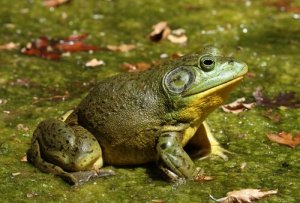
The bullfrog is an invasive species that lives in almost all parts of the world. Not only is its birthrate high, but it’s also aggressive. Therefore, it’s capable of displacing and destroying other weaker species.
The bullfrog is an amphibious animal of the Anura order, belonging to the Ranidae family and the Lithobates genus. Its scientific name is Lithobates catesbeianus.
Even though it’s hard to believe, this invader is originally from the eastern part of North America. Whether deliberately or by chance, it’s now invading parts of America and Eurasia. Its common name comes from its characteristic croak. Deep and noisy, it sounds like the bellowing of a bull.
Experts consider the bullfrog to be an extremely effective invader. In light of the fact that it’s difficult to erradicate where it invades, it negatively affects other species. It follows that it’s on the list of the 100 most invasive species of the world, according to the International Union for the Conservation of Nature (IUCN).
Characteristics of the invasive bullfrog
The approximate size of a bullfrog is between four and six inches. Like any other amphibian, it grows rapidly in the first eight months of life. In this maturation process its weight increases from one-fifth of a pound to less than a half pound. In extreme cases, a bullfrog can weigh up to one pound.
Their color isn’t uniform since it can vary from brown to different tones of green. Frequently it has dark colored spots on its chest.
The male bullfrog is much smaller than the female. Likewise, the eardrums vary according to the sex of the animal. The male has eardrums that are larger than those of the female, which has eyes and eardrums of the same size.
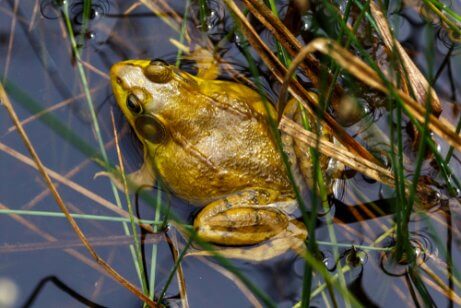
The bullfrog has the ability to hibernate and can live up to a decade. Moreover, this frog is a major carrier of parasites and disease, which can affect native amphibians. This is another characteristic that makes it a dangerous invading species in an ecosystem that’s not theirs.
The native range of this species runs from the south of Canada to the east and south the United States and to the north of Mexico. This species has been introduced to numerous countries around the work, mainly for commercial agriculture.
Where does the bullfrog live?
In South America, they have spotted wild populations of bullfrogs in Brazil, Venezuela, Ecuador, Columbia, Peru, Uruguay and Argentina. In the Carribean, they live in Cuba, Jamaica, Puerto Rico and the Dominican Republic.
When it comes to Europe, they are living in Spain, Italy, Germany, Belgium, Greece, France, the U.K., and the Netherlands. In Asia, they are found in China, Indonesia, Japan, Malaysia, Singapore, Thailand, Taiwan, Hawaii and the Philippines.
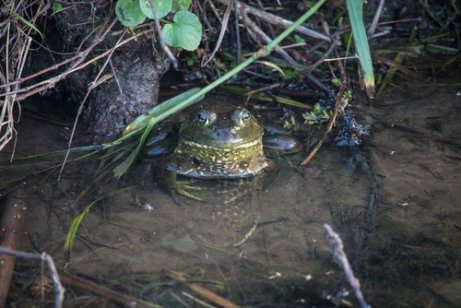
The bullfrog has a great ability to adapt, which makes it very easy to live in various ecosystems that it’s not native to. Its natural habitats are humid and peaceful areas, such as lakes and swamps. Nevertheless, it’s able to subsist in completely contaminated areas and other adverse conditions.
Behavior and reproduction
It’s noted that the male bullfrog has three types of calls. There are territorial calls that serve as a threat and warning to other males. The other two are either to attract females or to incite combat.
This amphibian eats a vast number of vertebrates and invertebrates. Among its victims are mice, all types of fish, snakes, tadpoles, birds, bats, freshwater crabs, snails, beetles, and even other bullfrogs. But its common diet is composed of insects.
The mating season usually lasts for two or three months. Males are usually located in an obvious area. This would be a riverbank where they can call females. In order to avoid conflicts, they stay at a prudent distance of from nine to eighteen feet apart.
After a female selects a male, she deposits her eggs in his territory. The male will fertilize the eggs externally once they are in his territory. The female can deposit up to 20,000 eggs in a group.
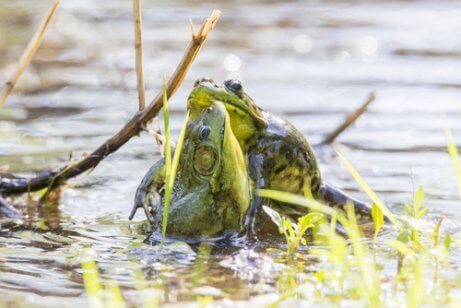
Tadpoles live in shallow water. Perhaps it’s because these areas have fewer predators. At this early stage, tadpoles eat single-cell algae, pollen, and other small particles.
Once they have grown, they start to eat larger items in their environment, using their teeth to scratch the surface. The time it takes for metamorphosis depends upon the area where they grow. In warm climates they can mature in a few months.
On the other hand, in colder places it may take up to three years, due to the colder water slowing down the metamorphosis process. The life expectancy of a frog is from eight to ten years. Uniquely, a bullfrog once lived for almost sixteen years in captivity.
The bullfrog as an invasive species
Invasive species are those that come from an area that they belong to and then go into an ecosystem that isn’t theirs. These invaders cause damage when they begin to establish populations and have offspring that reproduce in turn. Furthermore, they don’t have predators that can control their excessive reproduction.
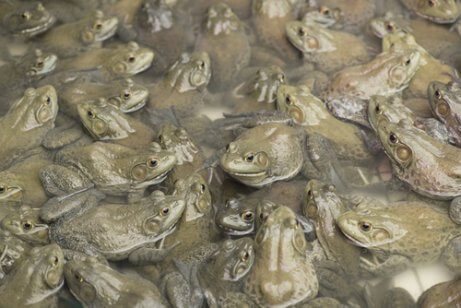
This invasive bullfrog causes an imbalance in the ecosystem since it competes for space and food with the native species. As a result, the original species of an ecosystem end up limiting their rate of reproduction.
Furthermore, they may eliminate native amphibians directly by way of preying on them or interfering with their search for food. At the same time, they can cause an imbalance in the habitat by introducing disease and parasites.
This frog is a carrier of the fungal pathogen called Batrachochytrium dendrobatidis that generates the disease called chytridiomycosis in amphibians. This is one of the villains responsible for the global extinction of amphibians.
The great diversity of its diet makes this frog a powerful predator. Wherever it goes it causes the local inhabitants to become extinct. By and large, this is what has happened in the countries where the bullfrog has gone.
The bullfrog is an invasive species that lives in almost all parts of the world. Not only is its birthrate high, but it’s also aggressive. Therefore, it’s capable of displacing and destroying other weaker species.
The bullfrog is an amphibious animal of the Anura order, belonging to the Ranidae family and the Lithobates genus. Its scientific name is Lithobates catesbeianus.
Even though it’s hard to believe, this invader is originally from the eastern part of North America. Whether deliberately or by chance, it’s now invading parts of America and Eurasia. Its common name comes from its characteristic croak. Deep and noisy, it sounds like the bellowing of a bull.
Experts consider the bullfrog to be an extremely effective invader. In light of the fact that it’s difficult to erradicate where it invades, it negatively affects other species. It follows that it’s on the list of the 100 most invasive species of the world, according to the International Union for the Conservation of Nature (IUCN).
Characteristics of the invasive bullfrog
The approximate size of a bullfrog is between four and six inches. Like any other amphibian, it grows rapidly in the first eight months of life. In this maturation process its weight increases from one-fifth of a pound to less than a half pound. In extreme cases, a bullfrog can weigh up to one pound.
Their color isn’t uniform since it can vary from brown to different tones of green. Frequently it has dark colored spots on its chest.
The male bullfrog is much smaller than the female. Likewise, the eardrums vary according to the sex of the animal. The male has eardrums that are larger than those of the female, which has eyes and eardrums of the same size.

The bullfrog has the ability to hibernate and can live up to a decade. Moreover, this frog is a major carrier of parasites and disease, which can affect native amphibians. This is another characteristic that makes it a dangerous invading species in an ecosystem that’s not theirs.
The native range of this species runs from the south of Canada to the east and south the United States and to the north of Mexico. This species has been introduced to numerous countries around the work, mainly for commercial agriculture.
Where does the bullfrog live?
In South America, they have spotted wild populations of bullfrogs in Brazil, Venezuela, Ecuador, Columbia, Peru, Uruguay and Argentina. In the Carribean, they live in Cuba, Jamaica, Puerto Rico and the Dominican Republic.
When it comes to Europe, they are living in Spain, Italy, Germany, Belgium, Greece, France, the U.K., and the Netherlands. In Asia, they are found in China, Indonesia, Japan, Malaysia, Singapore, Thailand, Taiwan, Hawaii and the Philippines.

The bullfrog has a great ability to adapt, which makes it very easy to live in various ecosystems that it’s not native to. Its natural habitats are humid and peaceful areas, such as lakes and swamps. Nevertheless, it’s able to subsist in completely contaminated areas and other adverse conditions.
Behavior and reproduction
It’s noted that the male bullfrog has three types of calls. There are territorial calls that serve as a threat and warning to other males. The other two are either to attract females or to incite combat.
This amphibian eats a vast number of vertebrates and invertebrates. Among its victims are mice, all types of fish, snakes, tadpoles, birds, bats, freshwater crabs, snails, beetles, and even other bullfrogs. But its common diet is composed of insects.
The mating season usually lasts for two or three months. Males are usually located in an obvious area. This would be a riverbank where they can call females. In order to avoid conflicts, they stay at a prudent distance of from nine to eighteen feet apart.
After a female selects a male, she deposits her eggs in his territory. The male will fertilize the eggs externally once they are in his territory. The female can deposit up to 20,000 eggs in a group.

Tadpoles live in shallow water. Perhaps it’s because these areas have fewer predators. At this early stage, tadpoles eat single-cell algae, pollen, and other small particles.
Once they have grown, they start to eat larger items in their environment, using their teeth to scratch the surface. The time it takes for metamorphosis depends upon the area where they grow. In warm climates they can mature in a few months.
On the other hand, in colder places it may take up to three years, due to the colder water slowing down the metamorphosis process. The life expectancy of a frog is from eight to ten years. Uniquely, a bullfrog once lived for almost sixteen years in captivity.
The bullfrog as an invasive species
Invasive species are those that come from an area that they belong to and then go into an ecosystem that isn’t theirs. These invaders cause damage when they begin to establish populations and have offspring that reproduce in turn. Furthermore, they don’t have predators that can control their excessive reproduction.

This invasive bullfrog causes an imbalance in the ecosystem since it competes for space and food with the native species. As a result, the original species of an ecosystem end up limiting their rate of reproduction.
Furthermore, they may eliminate native amphibians directly by way of preying on them or interfering with their search for food. At the same time, they can cause an imbalance in the habitat by introducing disease and parasites.
This frog is a carrier of the fungal pathogen called Batrachochytrium dendrobatidis that generates the disease called chytridiomycosis in amphibians. This is one of the villains responsible for the global extinction of amphibians.
The great diversity of its diet makes this frog a powerful predator. Wherever it goes it causes the local inhabitants to become extinct. By and large, this is what has happened in the countries where the bullfrog has gone.
All cited sources were thoroughly reviewed by our team to ensure their quality, reliability, currency, and validity. The bibliography of this article was considered reliable and of academic or scientific accuracy.
- Borges-Martins, M.; M. Di-Bernardo; G. Vinciprova y J. Measey (2002). “Geographic distribution. Rana catesbeiana”. Herpetological Review, 33: 319.
- Boelter, R. A. y S. Z. Cechin (2007). “Impact of the bullfrog diet (Lithobates catesbeianus. Anura, Ranidae) on native fauna: case study from the region of Agudo – RS – Brazil”. Natureza & Conservação, V-2: 115-123.
This text is provided for informational purposes only and does not replace consultation with a professional. If in doubt, consult your specialist.








